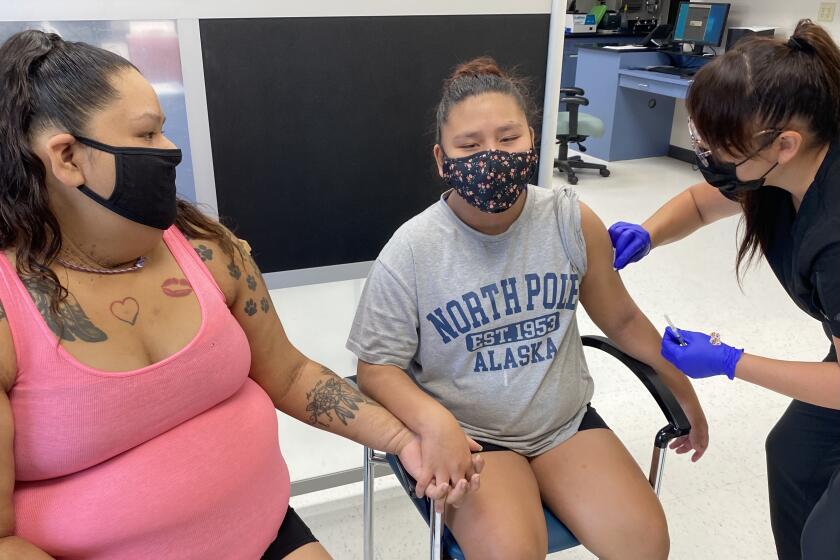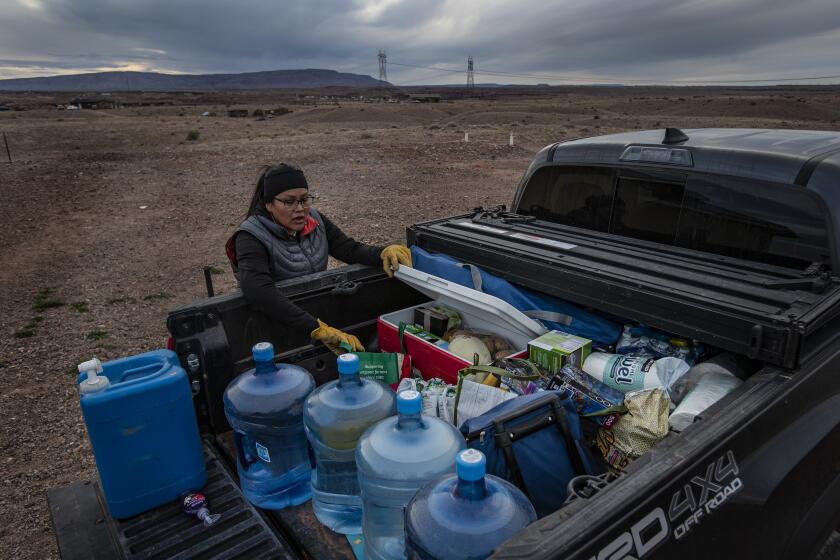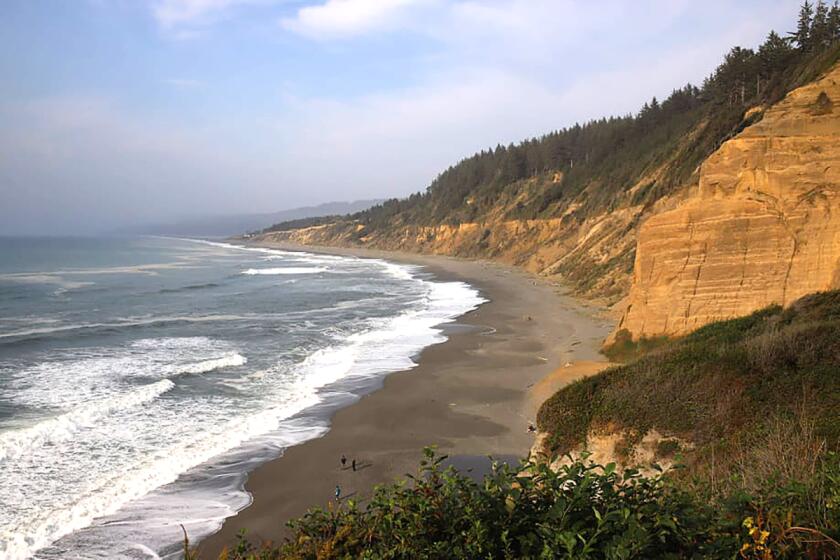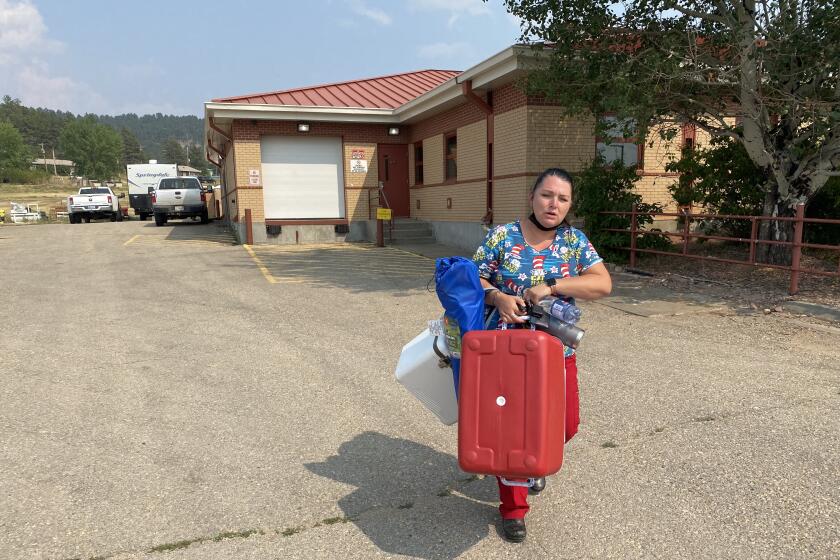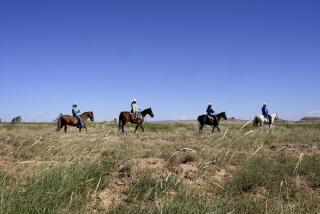A pageant like no other: ‘Can you imagine Miss USA or Miss Universe butchering a sheep?’
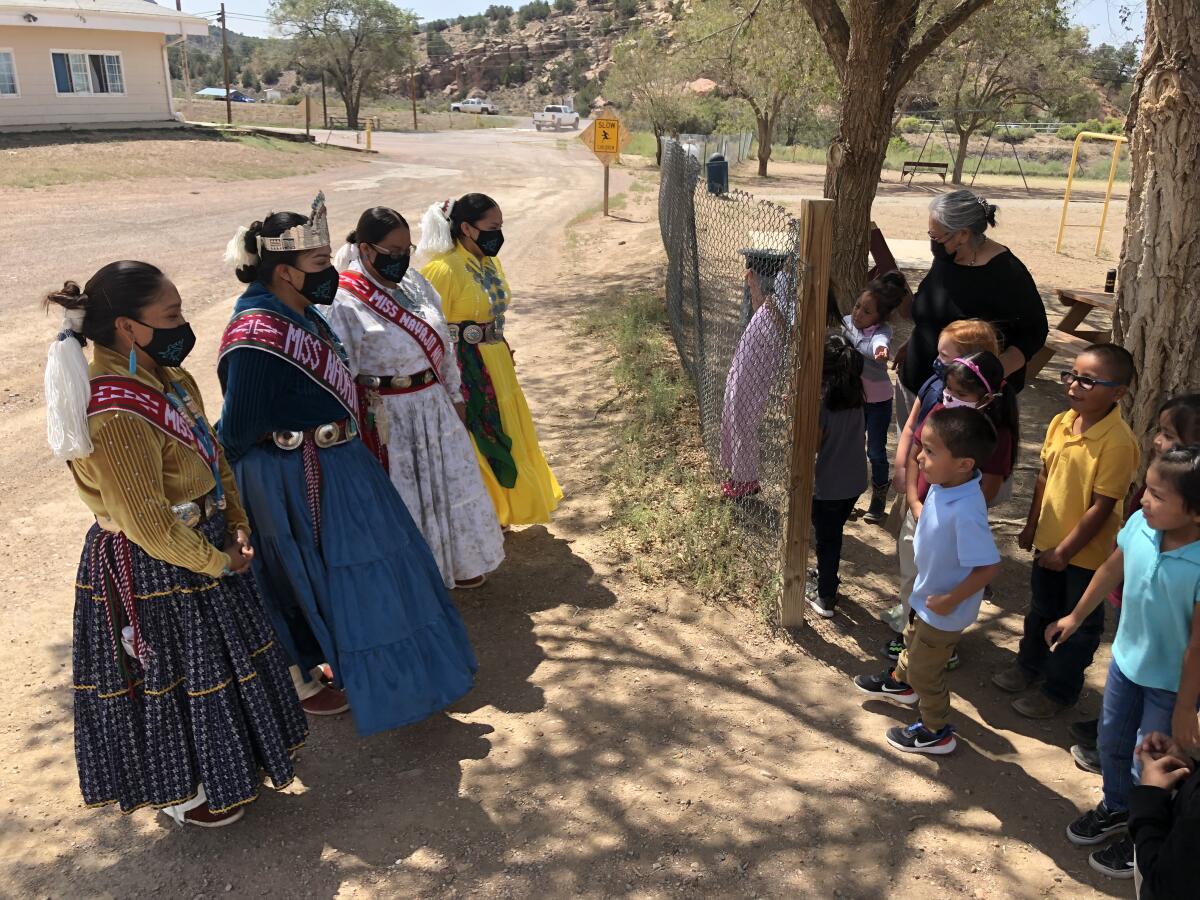
- Share via
WINDOW ROCK, Ariz. — The 69th annual Miss Navajo Nation Pageant began on a Monday just before 7 a.m. with three young women in long colorful dresses and aprons standing over a trio of trussed, bleating sheep.
For the record:
2:02 p.m. Oct. 11, 2021An earlier version of this article erroneously said that the reservation is 27,000 acres. It is 27,400 square miles.
The contestants patted the animals with small pine branches, blessing them.
“Let’s start the butchering,” the emcee said.
The women drew knives, grabbed the sheep by their chins and slit their throats. Blood spilled into the dirt.
The pageant is a contest like no other. At a time when the traditional way of life is ebbing, the competition is meant to showcase a deep knowledge of Navajo culture, customs and language along with skills needed to thrive in the modern world.
After canceling the six-day pageant last fall because of COVID-19 — which has killed more than 1,400 of the nearly 200,000 residents of the reservation here — tribal leaders resurrected it in early September, keeping the public out, but welcoming select journalists and a Navajo video crew that livestreamed the competition on YouTube and Facebook.
Native Americans often live far from healthcare facilities and distrust federal authorities. Still, they’re getting vaccinated against COVID-19.
Gathered inside a white tent, the contestants had one hour to kill, skin and gut the sheep, 30 minutes to clean the intestines and 20 minutes to cut up the meat.
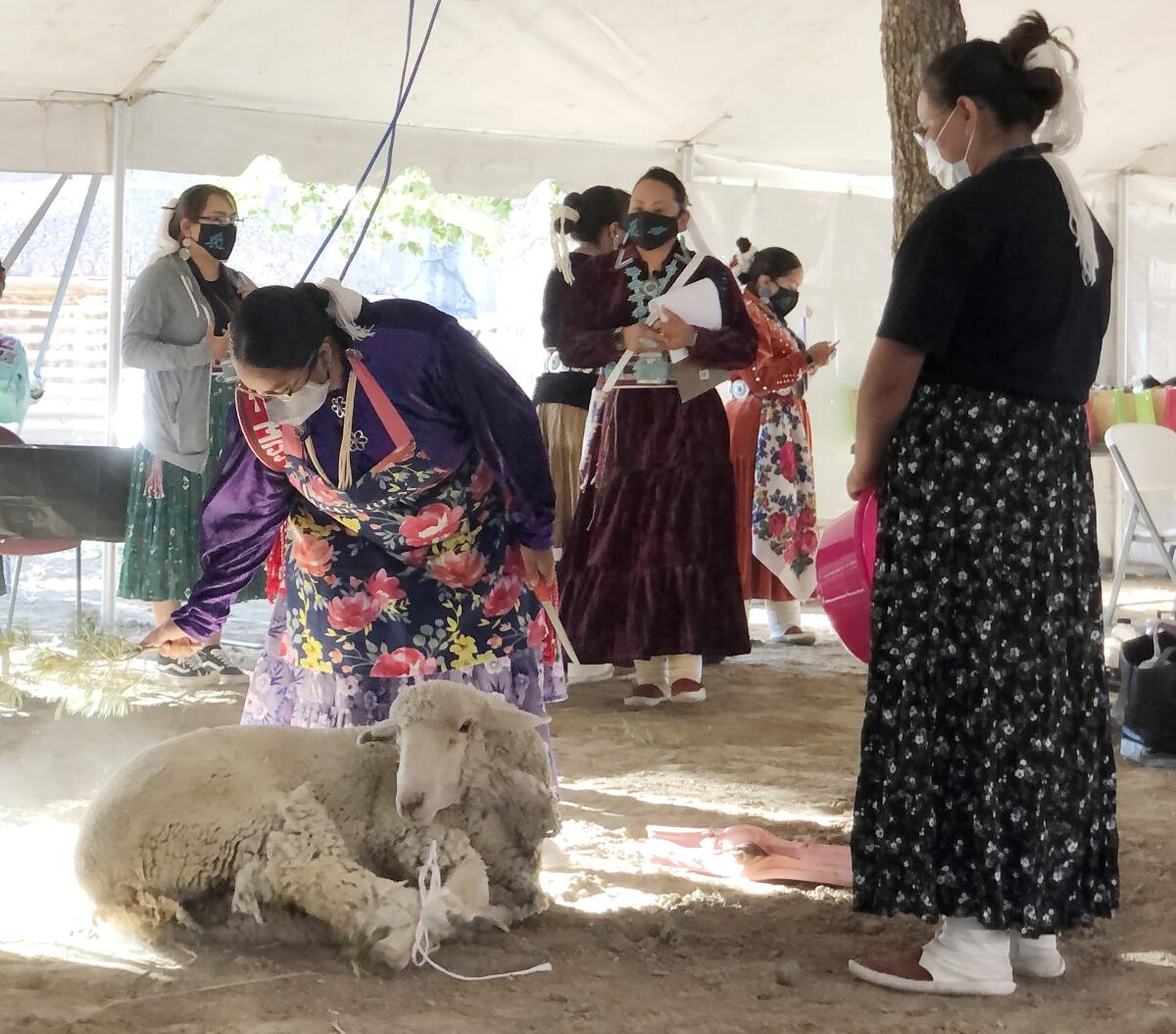
Shandiin Yazzie, 25, battled through the sheep hide.
“Medic!” she cried, after slicing her finger. It was bandaged but later required five stitches. She kept cutting.
One of her two competitors, Oshkaillah Lakota Ironshell, 19, flayed her sheep’s belly, methodically separating skin from meat.
As the women worked, three judges circled with clipboards and peppered them with questions. Why did you cut here? What is this piece used for?
Niagara Rockbridge, 22, knew every answer. In 45 minutes, well ahead of the other two competitors, she had skinned and eviscerated her sheep and was cleaning intestines.
“Miss Navajo Nation is the ultimate Navajo woman,” she said. “It is the ultimate competition because it is really testing the inner and outer strength of the contestant. Can you imagine Miss USA or Miss Universe butchering a sheep?”
Many Native Americans don’t have access to clean water, increasing their risk of illness. Fixing the current water systems or creating new ones could cost billions.
::
The first Miss Navajo Nation pageant, held in 1952 as part of the Navajo Nation Fair, was attended by thousands. It quickly became an annual event.
There were often more than a dozen contestants, who were judged for their appearance in traditional dress. Audiences chose the winner.
“An individual would take a cowboy hat and stand behind a young woman and put the hat on top,” said Sophina Shorty, who won in 1988 and served as a commentator for the broadcast this year.
“Whoever got the loudest applause was the winner.”
Back then, before there were many supermarkets on the reservation, butchering was a common skill, and Navajo was widely spoken.
As the language and traditions began to fade, the pageant took on new meaning and urgency.
In a matrilineal society where women are revered as keepers of knowledge, Miss Navajo Nation came to represent the ideals of traditional womanhood.
“Women have a respected position in our culture,” said Sunnie Clahchischiligi, a Navajo member and journalist. “Not only do they give life, they perpetuate life and knowledge for us.”
Over the years, more events were added, including rug and basket weaving, knowledge of the language, preparation of traditional food and a business interview competition.
“Many of those who died were our knowledge and wisdom keepers. We have lost lives, but we still have strength within us. I want to help preserve and revitalize our language and traditional way of life.”
— Niagara Rockbridge
The addition of sheep butchering in 1996 was a nod to the importance of the animal in Navajo culture. Aside from the wool, meat and milk they provide, sheep figure prominently in songs, prayers and sacred ceremonies of the Dineh — the people — as the Navajo call themselves.
But few young people learn how to butcher a 70-pound ewe, and the requirement is one of the biggest reasons fewer women are competing. Contestants must be unmarried and 18 to 25 years old.
Just two entered in 2019. Organizers were grateful for the three this year.
Yazzie, who attended a Navajo-language immersion school, sings in a punk rock band and in 2019 performed the part of Mommy Shark in the Navajo-language version of the hit children’s song “Baby Shark.” She described herself as a “bisexual, queer Dineh woman.”
Indigenous leaders have long asked the U.S. to take accountability for severing children from their families, language and religion.
With plans to become a lawyer, she is passionate about Black Lives Matter, homelessness and the work she does on violence reduction on the reservation.
“I see this as a chance to speak out on those issues,” she said.
During the pandemic, she delivered food across the reservation to people with COVID-19.
“Some families don’t have water to wash their hands, and some places didn’t have electricity to run a ventilator,” she said.
Rockbridge, who works with her father in their electrical, air-conditioning, heating and plumbing business, grew up raising sheep and horses with her family. Navajo was spoken at home, and traditional beliefs and songs were part of life. Her grandmother taught her how to butcher.
Rockbridge won her first pageant at age 5 and went on to triumph in all 10 she entered. The pandemic motivated her to seek the Miss Navajo Nation title.
“Many of those who died were our knowledge and wisdom keepers,” she said. “We have lost lives, but we still have strength within us. I want to help preserve and revitalize our language and traditional way of life.”
Ironshell was raised Christian and was not immersed in the Navajo language. Her father, a Lakota Sioux, was homeless. She routinely called him at shelters to make sure he was safe. Two years ago, he died.
She recalled their last conversation.
“He told me, ‘Be strong and learn your Dineh culture,’” she said. “That’s what I am doing. It takes a lot to be a Dineh woman.”
A month before the pageant, her mother hired a teacher to show her how to butcher. Ironshell hung pictures of sheep parts on her wall and memorized them.
With the butchering done, contestants built fires and boiled pots of Navajo tea made with local herbs. They cooked traditional food — squash and corn, goulash of sauteed liver and intestines from the sheep they butchered.
The judges ate and took notes.
::
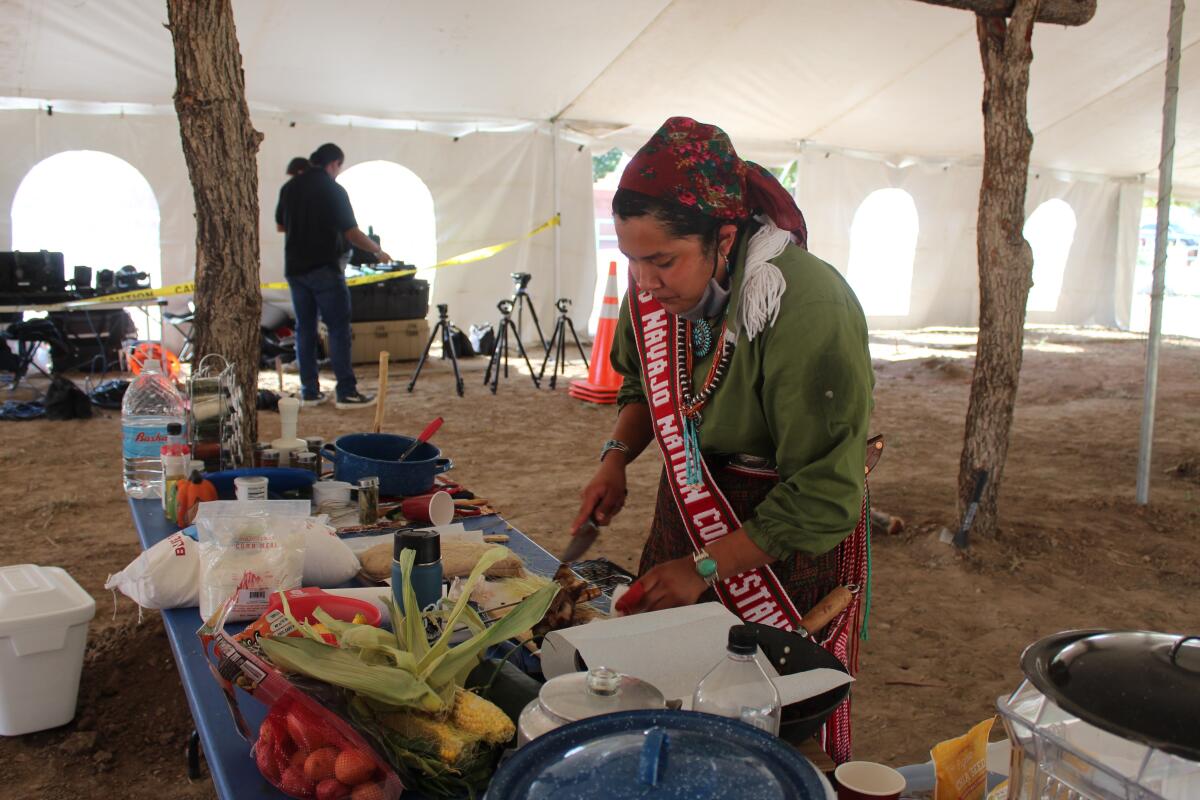
The next four days were a whirlwind of performance, reflection, public service and meetings with Navajo officials.
At one point, the contestants each took 10 questions onstage inside the auditorium of the Navajo Nation Museum.
Describe the tribe’s relationship with the United States. How does Indian gaming affect the Dineh? How would you increase use of the Dineh language and culture?
Yazzie was asked about the impact of domestic violence on the community. Thousands of women and girls have been reported missing or murdered on reservations across the nation including here, where poverty, alcoholism and drug abuse remain serious problems.
“I’ve seen it, I’ve endured it, and I know a lot of my friends have been a part of domestic violence,” she said. “There are no shelters for battered women here.”
“Trauma is one of the things we never talk about due to Navajo teachings of whatever happened, you don’t talk about it, you leave it in the past,” she said. “There is a lot of untouched trauma that we need to address.”
The name change is the first of its kind for a California park, part of a broad effort to identify and rectify derogatory names attached to state parks and transportation systems, officials said.
On the subject of Indian gaming, Rockbridge said it was a misconception that all Native Americans get individually paid by casinos.
“That goes to our businesses, our trust funds … to help everyone on the nation,” she said. “Indian gaming is utilized as an economic stimulant … so we can create generational wealth for our people. Some may not agree … but Indian gaming is working so if it’s not broke, don’t fix it.”
Ironshell struggled with the questions, declining to answer about half of them, but winning support from some of the tens of thousands of people watching online.
“Maybe the woman who can answer these should run for Navajo Nation president,” one person watching on YouTube wrote in the comments section.
In another session, Rockbridge came onstage in jeans and a tool belt and carrying a drill. An upright board held two blue switch boxes, wires and a light.
“Now I will demonstrate how to wire an outlet, a switch, and at the end I will turn on a light,” she said.
The drill whined in the silent auditorium. She connected wires, flicked on the light and announced: “And you have power.”
Yazzie’s talent was singing. She belted out a few stanzas of the 1974 hit “Come and Get Your Love” by the band Redbone, followed by “Bad Moon Rising” by Creedence Clearwater Revival.
For the traditional talents and skills competition, Rockbridge chanted a Navajo song about corn. Yazzie displayed rugs she had woven. Ironshell danced.
When it was time to take questions in Navajo, however, Ironshell stood onstage with closed eyes.
The language is famously difficult with tones and glottal stops unlike anything in English. The U.S. military created a code based on the language during World War II. A group of Navajo Marines serving in the Pacific, known as Navajo code talkers, transmitted messages using the code, and the Japanese never cracked it.
When the first question came, Ironshell said nothing. Seconds passed. Finally she left the stage and didn’t return, later saying she was overcome by anxiety.
Dottie Lizer, wife of Navajo Nation Vice President Myron Lizer, told viewers that she didn’t grow up speaking Navajo either.
“I was raised in a Christian home,” she said, her voice breaking with emotion. “That doesn’t mean I don’t love my culture or my language. So have some compassion for her.”
::
Miss Navajo Nation is a yearlong, paid government job working out of the president’s office as an ambassador of culture and goodwill. She gets a house in Window Rock, the tribal capital, as well as a small administrative staff, a college scholarship and a car and driver when available.
The 2019 winner, Shaandiin Parrish, visited all 110 chapter houses — centers of local government — on the 27,400-square-mile reservation, which stretches through parts of Arizona, New Mexico and Utah.
When the pageant was canceled last year, Parrish was asked to serve a second term, spending much of her time delivering food, masks and gloves — always wearing moccasins, a traditional velvet dress, heavy jewelry and her sash and crown.
“I never hesitated,” she said. “I am far more secure and confident of who I am and who I will become after two years of putting myself second to my people.”
She met with the three contestants at locally owned Latte Abini Coffee on a day set aside for them to learn the job. Customers immediately asked to take their pictures.
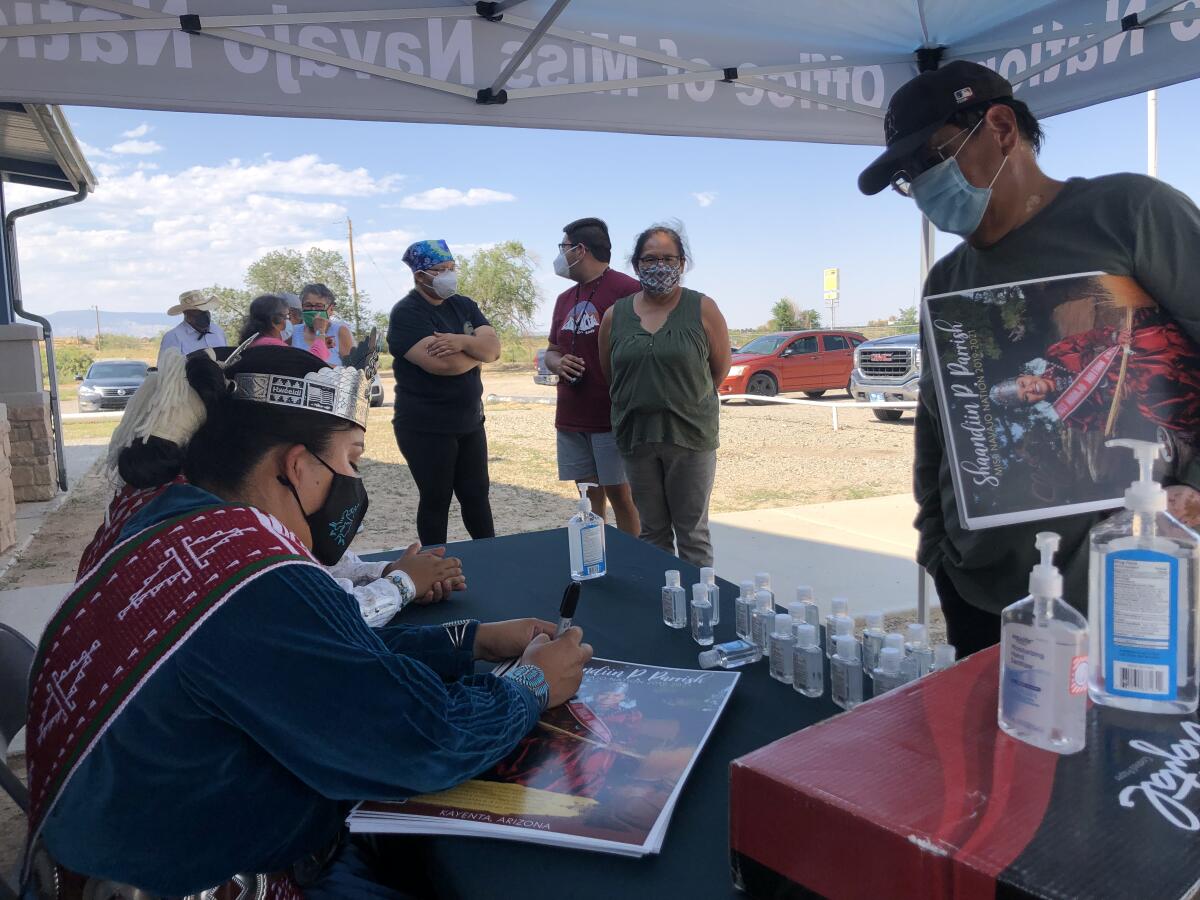
“They are the epitome of what a Navajo woman should be,” said Kaylynn Tsosie, who had been watching the pageant online. “And they have to do it in all this regalia. As a Navajo woman, I can tell you those dresses are not breathable in this weather.”
It was 97 degrees.
After coffee, the women drove over to meet Pearl Yellowman, who runs the tribe’s Division of Community Development.
“When you travel this land like Shaandiin did, you will come to understand why some people have no electricity or running water or bathrooms,” she said. “Today we celebrated 25 houses getting electricity, tomorrow we will open a senior center.”
Shortly after the visit, Yazzie began feeling ill and was taken to a hospital and treated for heat exhaustion and dehydration.
The others dropped off a boxed artificial Christmas tree at a local Head Start program before going to Hilltop Christian School to distribute hand sanitizer, masks and gloves.
Distrust of the U.S. government could have led Native Americans to shun COVID-19 vaccines. Instead, they have the nation’s highest vaccination rate.
The entourage walked into a fifth- and sixth-grade class, where Parrish explained the office of Miss Navajo Nation.
A boy asked, “How much does your crown weigh?”
“4.3 pounds,” she replied.
Another boy asked whether she had a limo.
“Sometimes I get to drive with the president’s executive officers, and they have a black SUV,” Parrish said.
“Is it a Cadillac?” the student asked.
“It’s a Chevy.”
As they entered Norma Nelson’s kindergarten class, students sang “Jesus Loves Me” in Navajo. Rockbridge urged them to keep learning their language.
It was getting late and there was more to do. The women — minus Yazzie, who was still recovering — headed for the remote Coyote Canyon Chapter House.
There, across the road from the remains of an old trading post, they set up a tent emblazoned with the Miss Navajo Nation logo and prepared to greet residents.
Cars immediately pulled up, and a line formed. Parrish sat at a table signing posters of herself.
“Thank you for taking care of us for two years,” said Valentina Benallie, who got posters for her grandchildren.
::
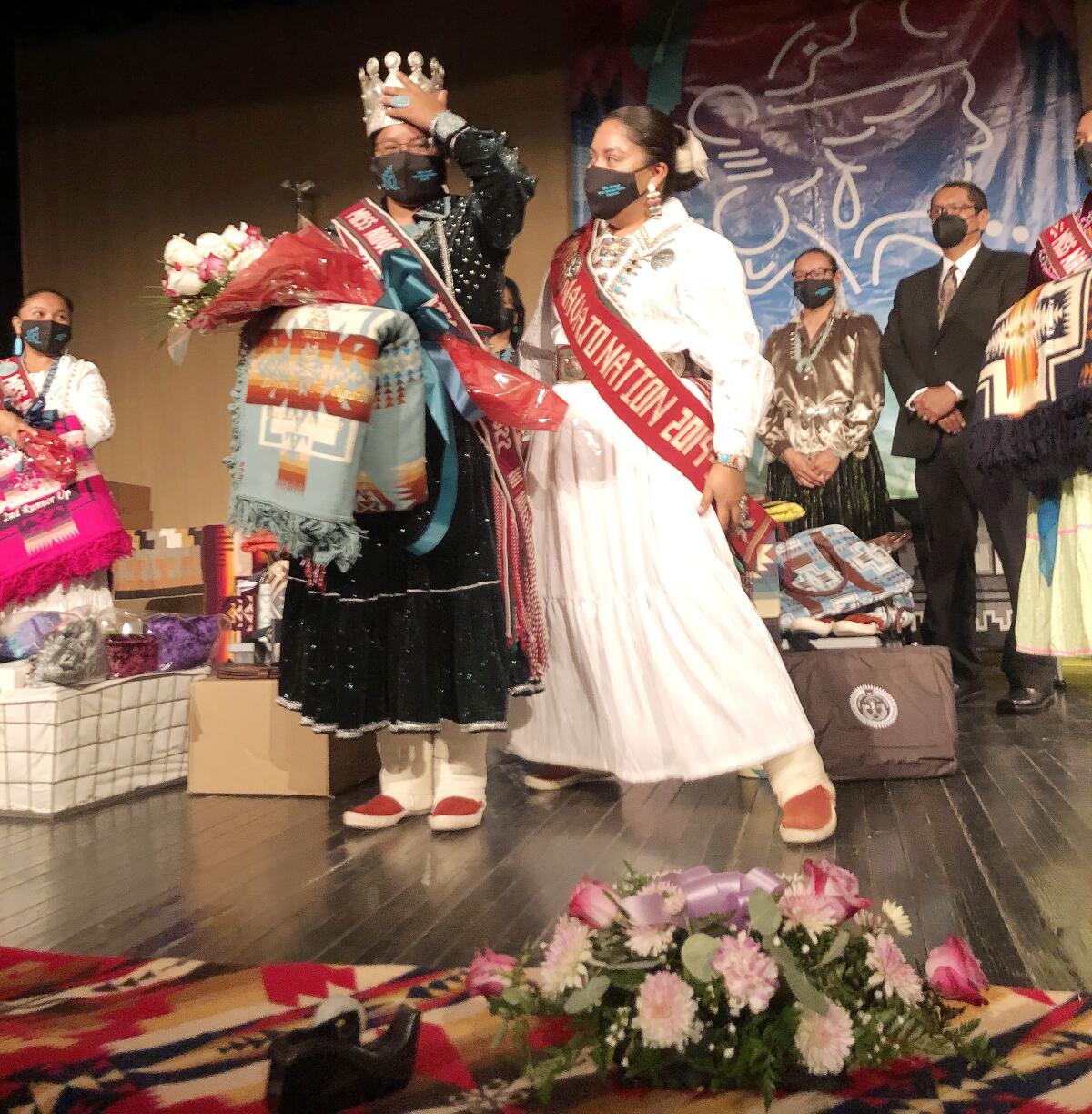
On Saturday, the contestants walked into the auditorium for the last time.
Family members sat in designated seats. Everyone wore masks.
“They showed all their talents, underwent tremendous pressure and never wavered,” the Navajo Nation president, Jonathan Nez, told viewers. “I even learned new ways to butcher and even jumped in to hoist a sheep. I got comments: ‘Did you get blood on your suit?’”
A new map of Los Angeles County made by UCLA and CIELO, an Indigenous organization, seeks to document where Indigenous languages are spoken.
The contestants stood quietly as Parrish said her farewell and Alfreda Lee from the tribe’s Office of the Auditor General carried the results to the podium.
“The second runner-up is Oshkailiah Ironshell,” she said.
“The runner-up is Shandiin Yazzie,” Lee said.
Each received hearty applause as well as rugs, moccasins and jewelry.
“And the winner of Miss Navajo Nation,” Lee said, “is Niagara Rockbridge.”
A new crown was unveiled depicting female Navajo deities including White Shell Woman and Spider Woman. Parrish placed it on Rockbridge’s head.
After two years of working to blend the modern and traditional, she was off to Arizona State University to get a master’s degree in business. Now it was Rockbridge’s turn.
More to Read
Sign up for Essential California
The most important California stories and recommendations in your inbox every morning.
You may occasionally receive promotional content from the Los Angeles Times.
